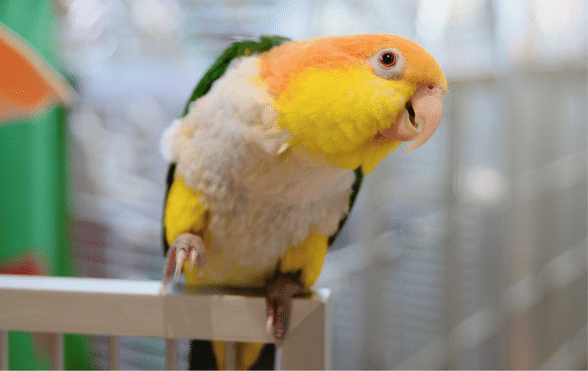Parrots have danced their way into neuroscientists’ laboratories as we try to understand what’s behind their talant for dancing
Is your parrot insured? Get a quote for up to £5,000 of vet fee cover, death and theft cover | We’ve been insuring exotic pets since 1996 | Check out our customer reviews on Feefo.
Parrots groove in rhythm to the tempo of the music they hear because of a “link between the auditory and motor parts of the brain”, according to a theory put forward by Dr Aniruddh Patel from the Neurosciences Institute, San Diego.
To test this hypothesis, Patel’s team studied the famous Sulphur-Crested cockatoo Snowball who became an internet sensation after his YouTube video of dancing to a Backstreet boys song went viral in 2007.
He and his team were surprised to observe that the parrot’s movements were synchronised with the beat – something that until then had only been observed in humans. Not only could Snowball move to a rhythm, he could also adjust to a new one when the music changed.
Also, in this article: Are dancing parrots simply mimicking somebody in the room? | Could Snowball’s ability to dance be the result of training? | How can you train a parrot to dance?

It seems that parrots’ talent for vocal mimicry may be linked to their talent for dance
Are dancing parrots simply mimicking somebody in the room?
Dr Patel and his team played the parrot his favourite song at various rhythms. No one in the room was allowed to respond to the music in any way, including involuntary rhythmical movements, dancing or vocalisation.
Although Snowball wasn’t always 100% in rhythm, his tempo changed accordingly with that of the song.
This led to the conclusion that Snowball had the innate ability for spontaneous beat perception and synchronisation and danced independently from cues in his environment.

Studies hint that parrots are naturals at dancing
Could a parrot’s ability to dance be the result of training?
It is not entirely clear whether Snowball’s abilities were in any way influenced by earlier training.
Not much is known about Snowball’s life before the age of six which has led some to wonder if his previous owners might have trained him to dance.
In addition, the owner who rehomed him at the age of six might have had an impact on his ability to dance too.
When he first noticed the parrot bobbing his head to Everybody by Backstreet boys, the owner and his children responded by dancing along with the parrot and making rhythmical movements with their arms. It also seems that the Backstreet boys song was usually the one played for him to dance to. Soon after Snowball added his rhythmical foot-lifting to his dancing routine.
To find out if that could indeed be the case, Dr Scachner from the Massachusetts Institute of Technology (MIT), and her team recorded an entirely new piece of music and played it to another famous parrot – the late African grey Alex.
The bird responded to the music with a similar rhythmical accuracy to that of humans which led the team to believe that this behaviour could not be the result of training or familiarity with the tunes.
The African grey Alex was a subject of a 30-year study where he learned to perform complex tasks related to language and understanding, which could solidify Dr Patel’s idea that there is a link between neurological circuits responsible for complex language learning and rhythm processing and synchronisation.
After the second team concluded their experiment with studying over 4,000 YouTube videos of “dancing” animals and identifying that only the ones capable of vocal mimicry were the ones also capable of following a rhythm, they were in agreement with Dr Patel’s theory.
However, parrots are rather impressionable exactly because of their special ability for mimicry, which means that you might be able to train your parrot to dance.

Parrots’ amazing ability for mimcry makes them easy to train
How can you train a parrot to dance?
The basics are pretty easy: you need to catch your parrot in a moment when it wants your attention, play a fast-paced tune with a strong beat and do the moves yourself while maintaining eye contact and using encouraging language. The simplest move to start with is head bobbing, something your parrot may even already know how to do.
It’s a monkey-see-monkey-do kind of deal, so be ready to perform some very unusual movements yourself. If your parrot seems distressed, pause and resume at another time.
You might find bells and other musical toys to be a good training aid.
It’s useful to remember that parrots have very short attention spans meaning it might be best to have short frequent sessions rather than long ones.
And don’t forget to reward it with a treat when it performs the desired dance moves.
Is your parrot insured? Get a quote for up to £5,000 of vet fee cover, death and theft cover | We’ve been insuring exotic pets since 1996 | Check out our customer reviews on Feefo.

